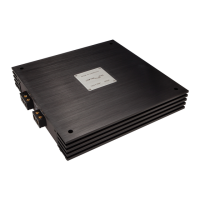Never bridge fuses or replace them with fuses with a higher amperage rating as such actions can destroy both of
WKHDPSOL¿HUDQGWKHHQWLUHHOHFWULFDOV\VWHPRIWKHYHKLFOH
Install the cabling in a manner which preludes any danger of the leads being exposed to shear, crushing or rupture forces.
If there are sharp edges in the vicinity (e.g. holes in the body work), all cables must be cushioned and protected to prevent
IUD\LQJ1HYHUOD\WKHSRZHUVXSSO\FDEOHVDGMDFHQWWROHDGVDQGOLQHVFRQQHFWLQJRWKHUYHKLFOHHTXLSPHQWIDQPRWRUV¿UH
detection modules, gas/petrol lines etc.). In order to ensure safe installation, use only high-quality connection materials.
As an aid to calculating the cross-sectional requirements of power cables which are not longer than 5 m, we recommend
PD[$SHUPPð)RUWKHDPSOL¿HU%5$;12;'63ZHVXJJHVWDPLQLPXPFURVVVHFWLRQRIPPðIRUWKHSRVLWLYH
12-volt supply lead and for the ground (chassis) cable. The remote lead should have a cross section of at least 1 mm². In
order to ensure the ideal sound quality and a distortion-free music rendition, please make sure that all cables are securely
¿[HGLQWKHUHVSHFWLYHWHUPLQDOV
Connection of the power supply
1 Connecting the remote lead
The remote lead is connected to the automatic antenna (aerial positive) or remote output of the head unit (radio). This is
RQO\DFWLYDWHGLIWKHKHDGXQLWLVVZLWFKHG217KXVWKHDPSOL¿HULVVZLWFKHGRQDQGRIIZLWKWKHKHDGXQLW
2 Connecting the battery cable
Connect the +12 V power cable to the positive terminal of the battery. Recommended cross section: min. 25 mm².
3 Connecting the ground cable
The ground cable should be connected to a central ground reference point (this is located where the negative terminal of
the battery is grounded at the metal body of the vehicle), or to a bright bare-metal location on the vehicle chassis, i.e. an
area which has been cleaned of all paint residues.
23

